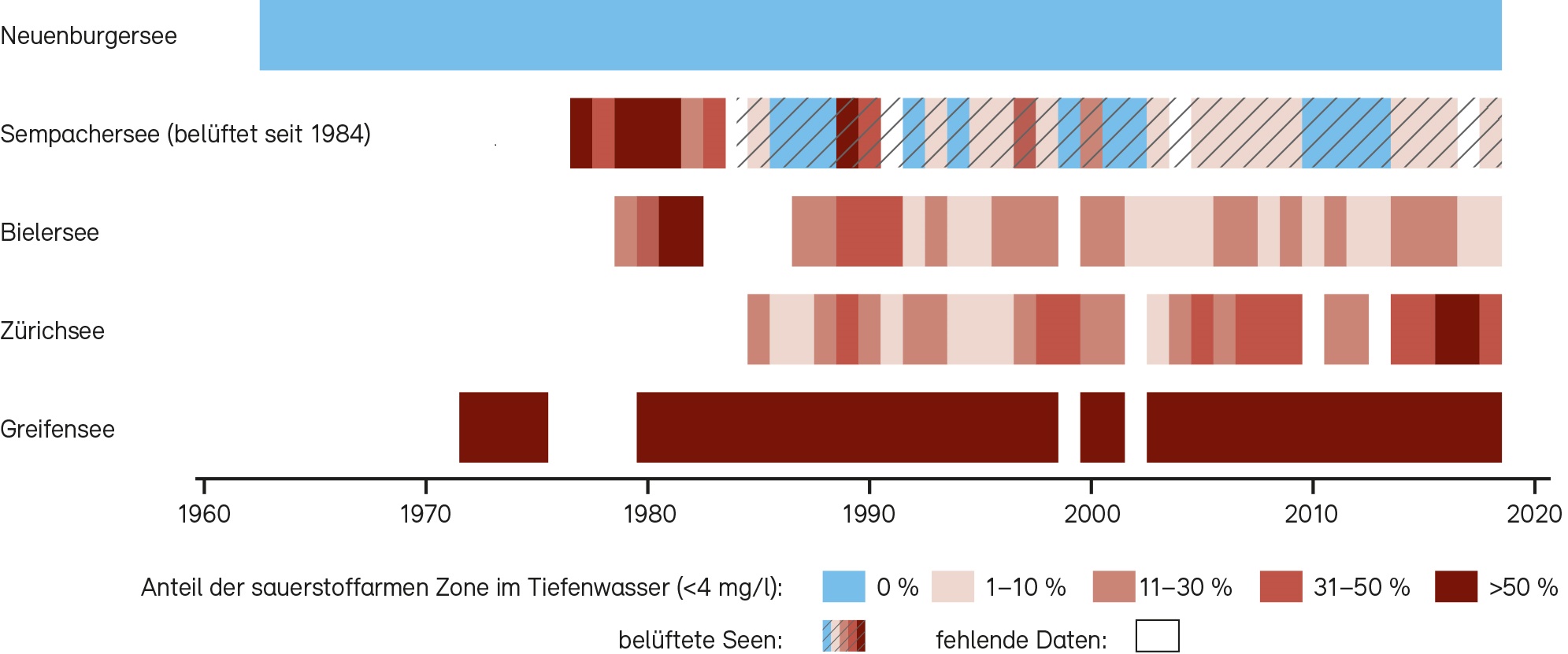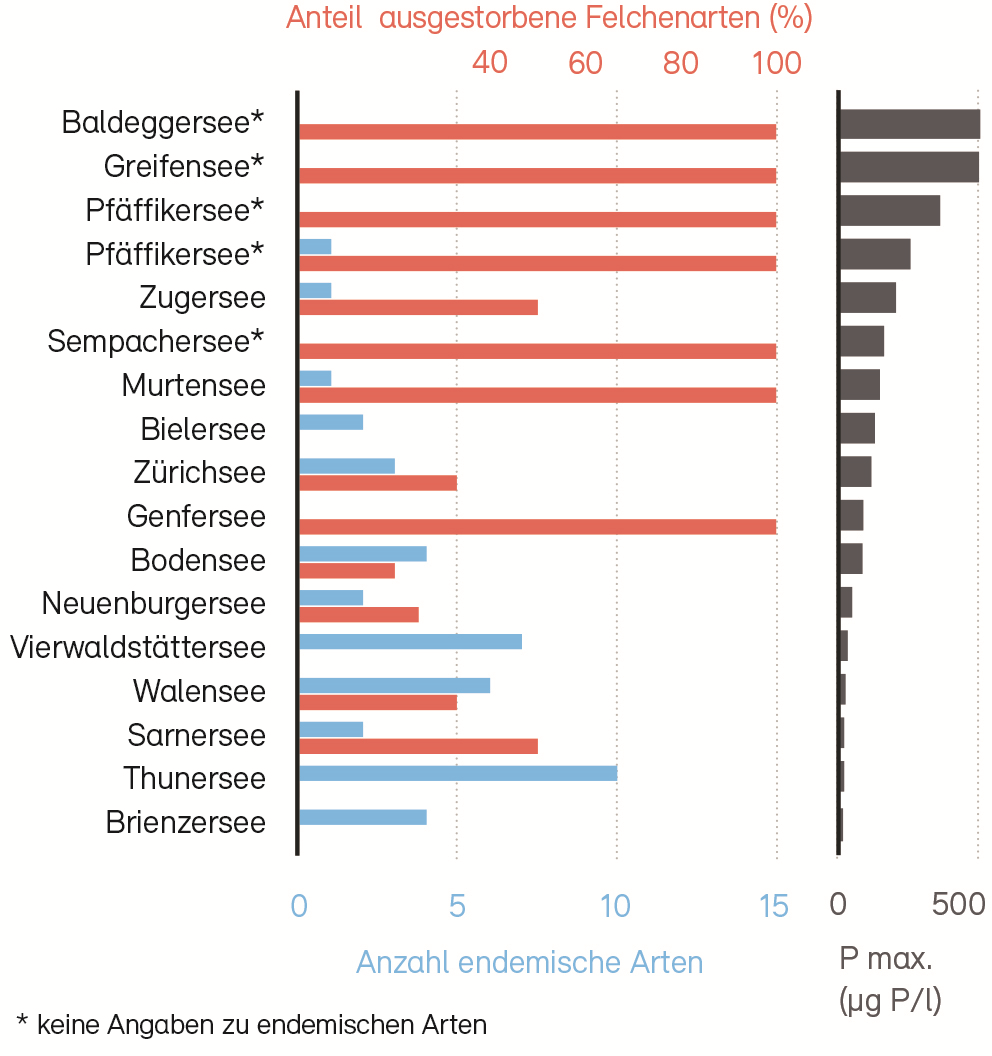Since the 1980s, the water quality of Swiss lakes has improved considerably, especially with regard to phosphorus content, which has declined markedly. However, individual lakes are still eutrophic and suffer from oxygen depletion. The concentrations of micropollutants in Switzerland's large lakes are generally below the limit values. The quality of water in lakes used for bathing is generally good. But plant and animal life in Swiss lakes is strongly impacted by human activity.
Phosphorus load in some lakes too high
While nitrogen inputs have remained constant over the last 20 years or so, phosphorus concentrations in most larger Swiss lakes have fallen to near-natural levels since the 1980s. The development of wastewater treatment and the 1985 ban on phosphate in laundry detergents have substantially reduced pollution. However, some large lakes still demonstrate high phosphate levels and so are eutrophic (over-enriched with nutrients). These lakes are either in regions where intensive cattle rearing is practised (e.g. Balleggersee) or in densely populated areas (e.g. Greifensee). Lake eutrophication promotes excessive algae growth. If a lot of algae are present in a lake, this depletes the oxygen in the deep water.
In many lakes, the oxygen supply in deep water improves as phosphorus concentrations fall. This is a continuous process. Nevertheless, the requirements of the Waters Protection Ordinance have either not yet been met or were met solely through artificial aeration in several lakes. Lower oxygen levels have been observed in the deep water of individual lakes due to reduced mixing.
Low oxygen levels at the lake bottom
Currently, a good 60 per cent of Switzerland's larger lakes do not meet the limit of four milligrams of oxygen per litre (e.g. Greifensee) or only do so thanks to artificial aeration (e.g. Sempachersee). Although the water quality has improved in many cases thanks to a reduction in the phosphate load, oxygen levels are recovering only slowly. This can be seen in Lake Biel, where the proportion of deep water containing too little oxygen has decreased since the 1990s, but still remains below the limit value every year. Even in lakes that have recovered, the oxygen concentration of deep water may decrease again in the future, since the water may circulate less well because of climate change (rising water temperatures). An example of this is Lake Zurich, where the amount of oxygen-depleted deep water is continuously increasing.
Of the small lakes studied by the cantons, only around two thirds have a near-natural level of nutrients. At lower altitudes, as many as half of the small lakes are over-polluted and suffer from eutrophication, primarily as a result of nutrient-rich run-off from agriculture.

Micropollutants mostly below limit values
Essentially the same pesticides, medicinal products and heavy metals are found in lakes as in rivers and streams. In large lakes, these micropollutants are present in lower concentrations and the limit values are generally complied with. Micropollutant contamination of lake sediments has not yet been studied in great depth. However, in some lakes it has been shown that substances such as heavy metals, polychlorinated biphenyls (PCBs), persistent pesticides and other organic pollutants are deposited in lake sediments over decades. Lake sediments are also heavily contaminated with pesticides in smaller waterbodies on the Swiss Plateau.
Plant and animal life strongly impacted by human influences
High nutrient loads in Swiss lakes in the 1970s and '80s had a strong influence on the plant and animal life found in them today. Algae levels have only returned to near-natural levels in one third of the larger lakes. In many lakes, the composition of the algae has also changed considerably in recent years, with consequences for the entire food web. For example, blue-green algae (cyanobacteria) have tended to spread. Only lakes that have never experienced excessive nutrient levels, such as Lakes Walen, Brienz and Lucerne, have a natural algae composition today.
Swiss lakes are inhabited by an above-average number of endemic fish species i.e. those that only have a small distribution area. When nutrient levels were at their peak, fish species that were adapted to life at great depths often died out due to the scarce oxygen at the lake bottom. Species of whitefish in particular were victims. Whitefish and char species are still only found living at great depths in lakes that have never experienced excessive nutrient levels, such as Lakes Brienz, Thun and Walen.
However, things are not all bleak. In Hallwilersee, macrozoobenthos are again found at greater depths thanks to improved oxygen levels‒. In Lake Lucerne, the noble fish coregonus nobilis, thought to be extinct, is again present, probably thanks to improved oxygen conditions. In some lakes whitefish are spawning again in deeper, more oxygen-rich layers – another positive development.

However, things are not all bleak. In Hallwilersee, macrozoobenthos are again found at greater depths thanks to improved oxygen levels‒. In Lake Lucerne, the noble fish coregonus nobilis, thought to be extinct, is again present, probably thanks to improved oxygen conditions. In some lakes whitefish are spawning again in deeper, more oxygen-rich layers – another positive development.
Information on the water quality in large lakes
The FOEN publishes status reports and key figures for Switzerland's major natural lakes. These are based on surveys by the cantons, international water protection commissions, Eawag and the City of Zurich water authority. Further information on the individual lakes can be found on cantons' websites.
Bathing water quality
The hygienic water quality of Swiss rivers and lakes is good. The public can swim safely in almost all lakes and rivers.
Further information
Links
Documents
Bericht UREK-N zu NP in Seen als Ergänzung zum Bericht Po. Standortbestimmung Fischerei_V2 (PDF, 327 kB, 10.11.2021)Konzentrationsverhältnis von Stickstoff (N) zu Phosphor (P) in Schweizer Seen
im Kontext des Po. 15.3795 der UREK-N «Standortbestimmung zur Fischerei in Schweizer Seen und Fliessgewässern»
Bericht zuhanden der UREK-N
Last modification 23.08.2022





